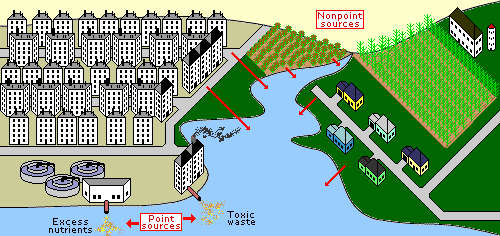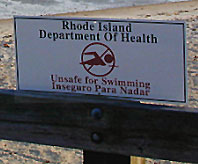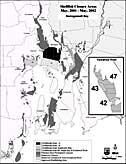 | |||||||||||||||||||||||||
 |
Policy and ManagementBacteria & VirusesMicroorganisms (including bacteria, viruses, and protozoans) are essential to all forms of life. There are billions of types of microorganisms that serve as building blocks for all kinds of ecosystems around the world. Most microorganisms are beneficial; they fill important roles such as helping humans digest food, aiding in the proper treatment of wastewater, and carrying out functions necessary to sustain the food chain. These helpful microorganisms are known as antigenic. The microorganisms that can cause harmful diseases are called pathogenic. The waters of Narragansett Bay may contain pathogenic bacteria and viruses that derive from human sewage and other sources. Microorganisms can be divided into several classes including: Bacteria - these tiny (13,000 individuals = one inch) single-celled organisms are present in the bodies of all living creatures, including humans. Bacteria play a vital role in processes such as decomposition and digestion. Bacteria can be found in large numbers in raw sewage, effluents, and in natural waters. Some well-known diseases caused by pathogenic bacteria include cholera, dysentery, shigellosis, and typhoid fever.It is important to keep in mind that seawater typically contains about 1 billion bacteria and 1 trillion viruses that are not pathogenic to humans.
Where do they come from? Pathogens may enter waters through point and non-point sources, while others may occur naturally in the environment. Some point sources are wastewater treatment facilities and combined sewer overflows. Non-point sources include land and road runoff, human sewage from recreational boats, and septic systems. The major sources of bacterial contamination are due to the point sources. Treatment facilities have greatly reduced the number of pathogens that are released into the environment though disinfectant processes. However, treatment is not always 100% effective and breakdowns in facilities sometimes occur. During heavy rains, there is too much water for the sewage treatment plants to handle, and some untreated or partially treated water maybe disposed into the Bay. Wildlife, domestic animals and birds may also contribute pathogens to the environment.
What are Combined Sewer Overflows? Combined Sewer Overflows (CSO's) are the largest contributor of bacteria and viruses to the Bay. CSO's combine residential, commercial and industrial wastes which carries pollutants in the form of sewage solids, metals, oil, grease and bacteria. During periods of heavy rain, the water in the CSO's combine with the storm water running over the land. The CSO then becomes overwhelmed with water which forces it to discharge untreated or partially treated wastewater into Narragansett Bay through the combined sewer overflow. Each year, billions of gallons of untreated sewage from combined sewer outflows are released into the Bay and its tributaries. How are waterborne diseases transmitted to humans? Other than through drinking water (which accounts for approximately half of the outbreaks and one-third of the illnesses mentioned above), pathogenic microorganisms can infect humans through primary contact such as swimming or water skiing, secondary contact such as boating or fishing, and ingestion of contaminated shellfish. Proper treatment of wastewater, combined with treatment of drinking water and immunizations, has nearly eliminated diseases like cholera, typhoid fever, and polio within the United States. These diseases are still prevalent in other parts of the world. Presently in the U.S., about two thousand illnesses and ten to twelve outbreaks per year are attributed to waterborne microorganisms. This is ten percent of the number of incidents that occurred prior to the development of public sewers and water treatment systems. How are Pathogens detected? It is impossible to test waters for every possible disease-causing organism. The Rhode Island Department of Health therefore measures for fecal coliforms and other sewage indicator bacteria in the Bay. The presence of bacterial indicators suggests that the water may be contaminated with untreated sewage and pathogenic bacteria or viruses may potentially be present. A criteria based on the indicator bacteria concentration are used to determine if waters are safe for human use. Bacteria from the fecal coliform group are used as indicators because they are not usually present in unpolluted waters and are easily detected by simple laboratory procedures. How do they affect Narragansett Bay? Bacterial pollution has caused over 40% of Rhode Island's waters to be either permanently closed or closed on a conditional basis to shellfishing. When coliform counts are high or swimmer's itch is identified, affected beaches may need to be closed to protect the people from potential sewage-derived pathogens. Harmful organisms associated with sewage include many different bacteria, viruses, and other organisms that may cause infections in swimmers or people who eat contaminated fish or shellfish. Bacterial contamination in parts of Narragansett Bay can restrict human uses, such as swimming, shellfishing and fishing.
What is being done about them? The main goal is to reduce the number of pathogens that are being discharged into the Bay. To reduce the concentrations of microorganisms that are released in to Bay, the Narragansett Bay Commission recently began work on the Combined Sewer Overflow (CSO) Abatement Project. Just as this construction project will prevent the release of excess nutrients into rivers leading to Narragansett Bay, it will likewise stem the flow of microorganisms discharged during rain events. By ending CSO discharge, this project will significantly improve water quality in the upper portions of the Bay, as well as the tributaries leading to it. To learn more about this project, please visit the Narragansett Bay Commission's web site at www.narrabay.com/cso.asp. In addition, municipalities must repair and maintain aging sewage collection systems to ensure proper treatment. Pump-out facilities are also being constructed to help the problem of sewage from marine toilets on recreational boats from being discharged directly into the Bay. Domestic animals are not allowed on beaches from spring to fall when recreational areas are in high use. In addition, feeding seagulls and other seabirds is not permitted in these areas.
|
||||||||||||||||||||||||


